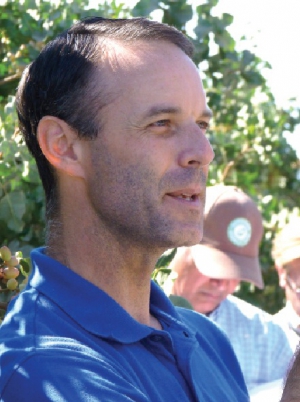
David Haviland, farm advisor in California’s Central Valley, says a new spotted wing drosophila lure is a useful tool for managing the pest. (Courtesy David Haviland)
The spotted wing drosophila has had a serious impact on California cherry growers.
Since cherry fruit fly is not found in California growing regions, growers haven’t had to spray regularly in the past.
“Typically, the cherry grower in Kern County would spray every few years —maybe one spray for mites,” said University of California Cooperative Extension farm advisor David Haviland. “You could go five years without a single insecticide. These same growers are putting on three sprays before harvest. That’s a major shift.”
Because a very high percentage of California cherries is exported, due to their high value there’s no tolerance for spotted wing drosophila.
Spread
Spotted wing drosophila, which originated in Asia, first appeared in the United States on the California coast in 2008. By the following year, it spread inland to California’s San Joaquin Valley, where Haviland is based, as well as north to Oregon, Washington, and British Columbia, Canada.
While the regions now share the same pest, its phenology is quite different. In Washington, for example, the pest seems to be knocked back (though not eliminated) by cold winter weather. Populations build up in orchards over the summer and peak in the fall. The insect does not go through a winter diapause.
In California, where the temperature rarely drops below freezing, the insects are active year round in at least one host crop, said Haviland. In cherries, populations tend to peak in the spring and fall and decline in the winter and during the extreme heat of the summer, after the cherries have been picked.
“Here, we don’t catch anything in the summer because it’s hot and dry. It can get to a hundred degrees every day for a couple of months,” he said. “It’s very, very different. Our big catches here are October through February.”
New lure
A new lure for spotted wing drosophila, which is based on research from U.S. Department of Agriculture researchers and commercialized by Trécé, Inc., is a valuable tool that should improve a grower’s ability to monitor the pest, Haviland said.
He tested the lure for a year and a half before it came on the market in April. The lure consists of two small plastic-coated containers that can be attached together to the top of a bucket trap using a paperclip. The drowning solution in the trap can be just water or water with antifreeze, which helps preserve the insects and stops them from turning slimy before they are counted.
In his evaluations, the lure was as effective in attracting spotted wing drosophila as apple cider vinegar, which is commonly used as an attractant. If apple cider vinegar is used as the drowning solution with the new lure, it catches three times as many flies as when the bait is vinegar alone.
Whereas in Washington growers monitor for the arrival of the pest during the growing season, California growers can assume it’s already there. They make two or three applications of pesticides within three weeks of harvest, starting when the cherries change color.
The main purpose of monitoring for spotted wing drosophila is to find out how effective a spray has been and if fly populations are building up to the point where another spray is needed. By monitoring populations they might be able to extend the interval before they need to reapply.
Haviland said growers might want to use the combination of the lure and vinegar if they’re trying to catch the maximum number of flies.
However, besides increasing the number of spotted wing drosophila caught, the vinegar attracts a lot of other insects and different species of drosophila, which makes servicing the trap more difficult.
If the grower doesn’t care so much about the number of flies and wants to make the trap easier to read, then the new lure works well, he said, noting that researchers at this point can’t tell growers what the number of flies means in regard to treatments. “There’s no treatment threshold,” he said. •






Leave A Comment